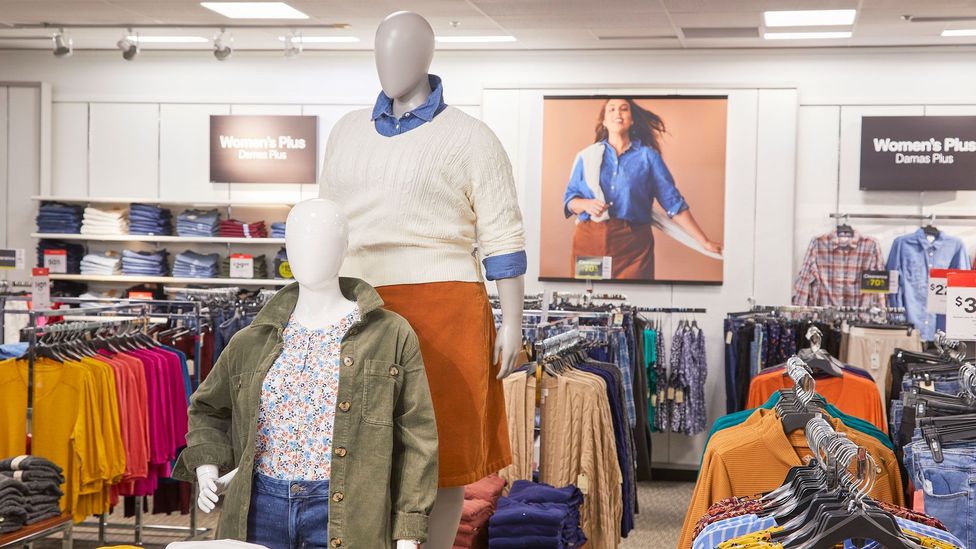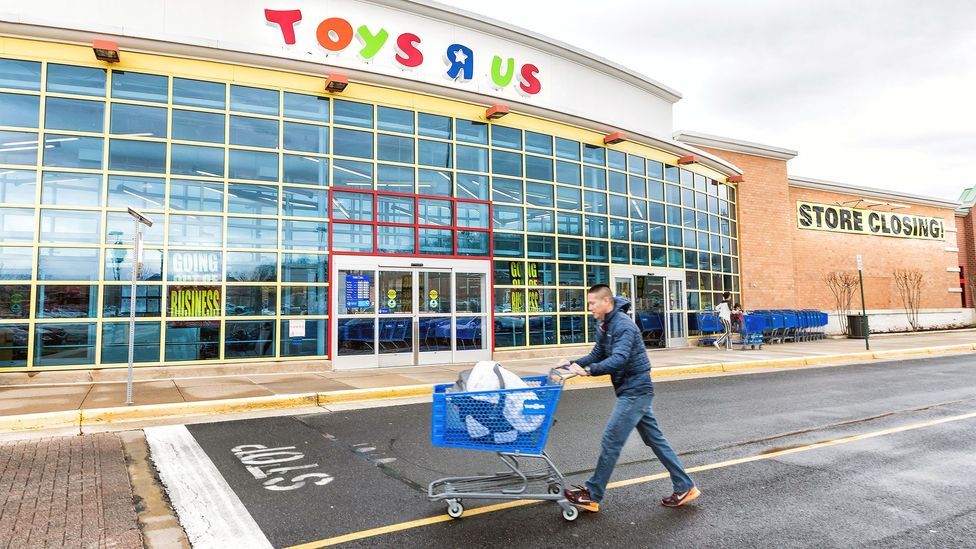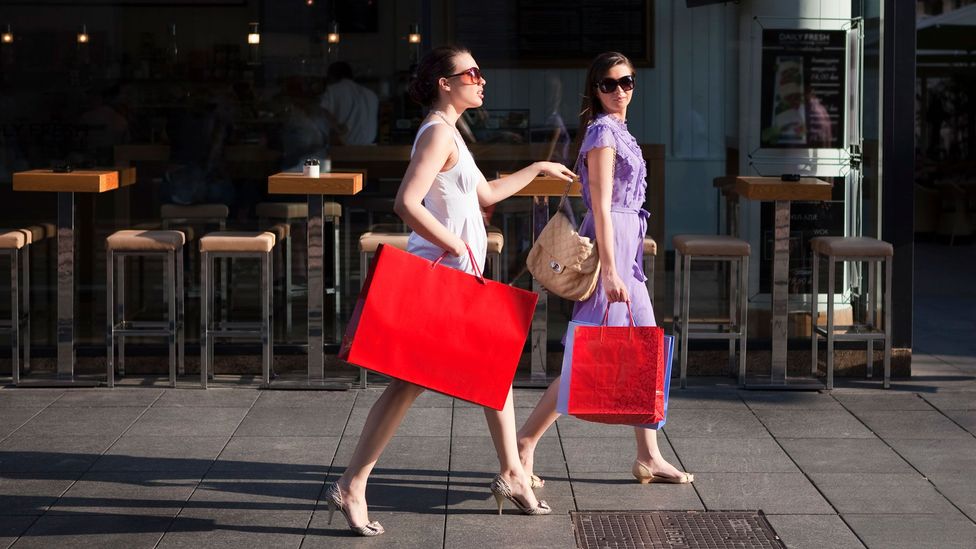At JCPenney stores across the US, shoppers may notice a fresh paint smell, better lighting and shiny new signage – with even more improvements planned for the coming months. Centralised checkout counters are replacing registers once spread across multiple departments, and posters promise a "new and improved shopping experience" once the remodels are complete. Change is afoot at the retailer, and not just in the form of upgraded carpet (though that, too, is on the list).
The updates are part of a $1bn (£808m) investment the company announced in late August – a pricey effort to reinvigorate the brand following a high profile 2020 bankruptcy and subsequent restructuring. The funds will be partly dedicated to slicker technology and improved e-commerce features, but much of the focus remains on JCPenney's more than 650 physical stores.
As a numbers game, this makes sense for the American department store chain: brick-and-mortar sales account for about 70% of the company's revenue, so enticing people to keep making those in-person trips will be crucial to recovery.
Beyond that, in surveys and focus groups, shoppers continue to emphasise the importance of stores, says Katie Mullen, JCPenney's chief customer officer. "Our customer tells us that they care about the store environment," she says. "They tell us that they care about product availability, and they tell us that they care about inspiration."
JCPenney is among the companies doubling down on their retail presences, for many different reasons. It may be surprising amid the recent narrative, in which experts and shoppers alike have declared once-thriving malls dead due to retailers' losing battles against Amazon, economic challenges, demographic shifts and better-managed competition. Indeed, vacant storefronts across the US have been converted to apartment complexes, pickleball courts, medical centres, coworking spaces and entertainment venues.
But while these trends paint a bearish picture of the future of traditional physical retail, some companies are making moves that suggest they still see in-store shopping as an opportunity for growth. Their strategies differ, but each are catering to what consumers say they want – and need.

The interior of a newly updated US JCPenney store (Credit: Courtesy of JCPenney)
Revamping forgotten stores
In-person shopping hasn't stopped, but it has slowed down. About 78% of global retail sales occurred offline in 2022, down from 85% in 2019. And amid the widespread growth of online shopping, especially throughout the past few years, brick-and-mortar stores have become an afterthought for many consumers. This behavioural transition has meant many middle-market retailers closed doors and tightened purse strings amid frenzied efforts to create glossy, easy-to-use e-commerce portals. It came at the cost of maintaining an inviting in-store experience.
But now, companies are pouring money back into neglected stores – and they're investing in more than just repairs. Across the US, retailers in all sectors are snapping up leases and placing big bets on brick-and-mortar. At the end of the second quarter of 2023, just 4.8% of all retail space in the country was available for lease, according to a report from commercial real estate information company CoStar, which noted the US retail space market was "at its tightest level on record".
What retailers are doing with that space is what sets today's approach apart from past endeavours. Yes, they're making sure the storefronts shine – but they're also building different kinds of physical spaces than they have in decades past. That's because consumer preferences have changed, and in many cases, they have even become more demanding.
"Consumers are looking for fast and easy checkout. They're looking for retailers to have the products they want in stock when they make the trip to the store," says Michael Brown, a partner and Americas retail leader at the global strategy and management consulting firm Kearney. "They're expecting a little bit more technology to help them navigate stores' assortments and aid their shopping experience, but not necessarily to just replace it."
Saks is pouring $250m to $270m (£202m to £218m) into upgrading its Fifth Avenue flagship, with features like a photogenic Rem Koolhaas-designed escalator, scaled up handbag department and dedicated shop-in-shops for brands like Alexander McQueen and Burberry
Shoppers, many retailers have discovered, are hungry for holistic experiences that go beyond two-dimensional images on a tiny screen. Offline, brands can invite people to linger at cosy in-house cafés, court VIPs with invite-only events and offer personalized styling and tailoring services. They can also simply give customers a place to try on a new lipstick shade or compare bedding sets – a valuable enticement after one too many online shopping fails.
Happy, shiny stores
Retailers are trying a number of tactics to capture what people want in today's shopping landscape. First, there are stores like JCPenney that are betting on operational and aesthetic upgrades to appeal to middle market shoppers who prefer the in-store experience: a kind of if-you-build-it-they-will-come approach.
Similarly, international fast fashion chain Primark is ramping up its expansion efforts stateside, opening its 21st US store in September, with the goal of scaling to 60 US stores (and 530 globally) by 2026. Along with expansive inventory, the company is also luring people into physical stores with ultra-discounted prices and a limited presence online.
Other companies are using their brick-and-mortar outposts as convenient hubs to complement their online storefronts and meet shoppers where they are. In contrast to the massive footprints of previous decades, Macy's, Target and Bloomingdale's are opening small format stores shops in urban centres and college towns that carry limited inventory selections. They come in at about a quarter of the size of the chains' typical footprints.
The model gives big-box retailers a way to stay connected with customers in places they couldn't previously reach. With tailored assortments of fast selling products and opportunities for e-commerce add-ons like click-and-collect, they're a popular and growing segment.
In the world's luxury corridors, destination-worthy redesigns have become a differentiator. Saks is pouring $250m to $270m (£202m to £218m) into upgrading its Fifth Avenue flagship, with features like a photogenic Rem Koolhaas-designed escalator, scaled up handbag department and dedicated shop-in-shops for brands like Alexander McQueen and Burberry.

Hailey Bieber with Tiffany & Co.'s president and CEO, Anthony Ledru, at the Fifth Avenue flagship's re-opening in April 2023 (Credit: Getty Images)
A few blocks north, Tiffany & Co reopened in April after a four year renovation that reportedly cost as much as a half-billion dollars. The iconic location, canonised in pop culture history by the film Breakfast at Tiffany's, is now home to ten floors of big ticket artwork by artists like Jean-Michel Basquiat and Jenny Holzer, an elegant in-house restaurant and an Audrey Hepburn-themed "experience room".
Last year, Tiffany parent company LVMH similarly upgraded Dior's Avenue Montaigne flagship in Paris – which now includes a spa, rose gardens and a museum dedicated to the brand's namesake designer. The company is banking on Tiffany's similar overhaul to brighten this beacon: more than two million people are expected to visit the flagship this year, many of whom will be drawn to its splashy exhibitions and cultural attractions as much as its diamond rings.
Experiential considerations are also at the forefront of the reinvention of Toys R Us and Babies R Us. Under the guidance of their new owner, the brands – which filed for Chapter 11 bankruptcy in 2017 and liquidated more than 700 stores – have recently opened flagships at the American Dream complex in East Rutherford, New Jersey. The stores are significantly smaller than previous iterations, and feature a host of new experiential elements, such as a stroller testing track, parenting classes and a nursery design centre in Babies R Us. At Toys R Us, shoppers can find a two story slide and ice cream parlour.
Ultimately, if retailers can convince customers to shop both online and in stores, they can reap significant rewards in terms of sales and loyalty. At Saks, a recent push drove a 26% increase in cross-channel shoppers. Among this segment, there was a 19% increase in orders per customer and a 9% increase in average order value.

A 2018 Toys R Us store closing in Fairfax County, Virginia, US, part of the company's move to file for Chapter 11 and liquidate its stores (Credit: Alamy)
Gold or gamble?
One unifying factor among stores that are defying the so-called "retail apocalypse" is a commitment to standing out and adapting to what shoppers want, especially as their dollars are not going as far. But that doesn't mean people are going to stop shopping: "When we enter a downturn, the consumer is still going to spend. Spending doesn't fall off 100%," says Brown.
Indeed, retail sales have remained relatively strong as consumers draw on their savings and charge purchases to credit cards. For businesses, this scenario presents both a challenge and an opportunity. "Retailers can't sit back and just look for a tide that's going to raise everybody's boats," he says. "They have to really make sure that they're stepping out there and doing something different and new to grab the share they can get."
Of course, heaping precious capital into store improvements is a gamble for any company – after all, these investments come with trade-offs. For instance, in JCPenney's case, if it goes after younger audiences, it risks alienating its older base; but if it sticks with what it knows, it might compromise future growth. Likewise, spending on upgrades now may mean sacrificing short-term profitability, but hopefully, these investments will pay dividends down the road.
These are the decisions every retailer today must face, says Brown. "Are they going to improve their supply chain? Their online experience? Their in-store experience? It's a matter of choices, and they're choosing the things that they can and can't afford to do at any given time."
